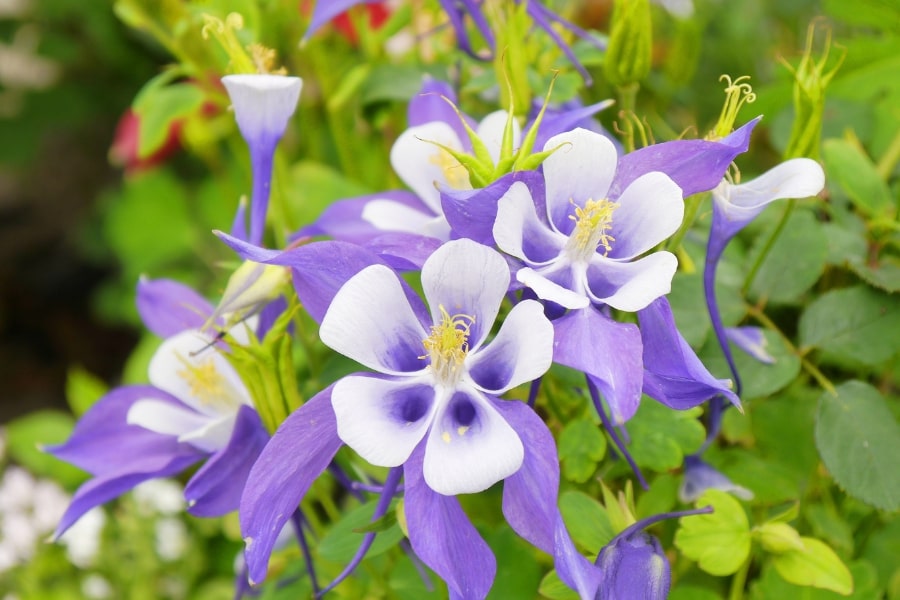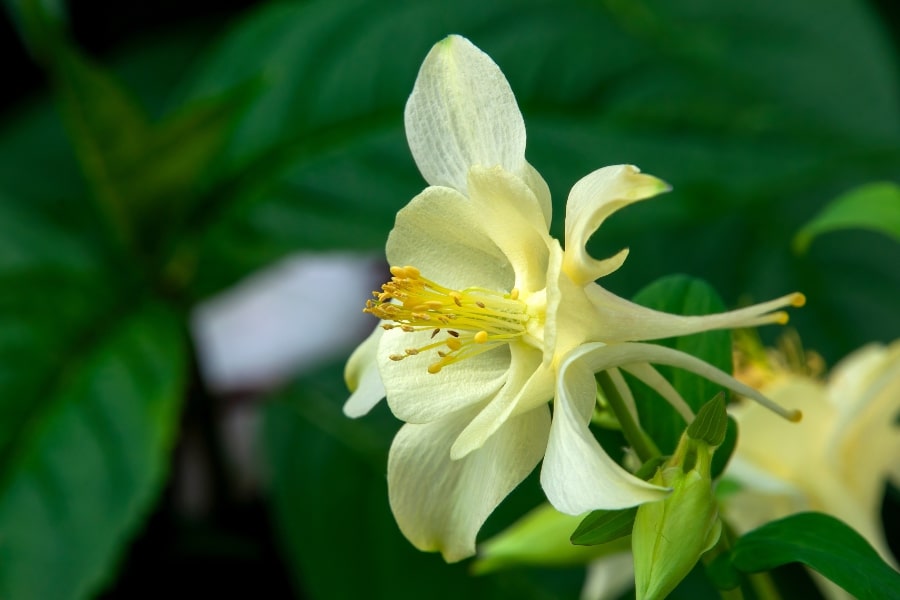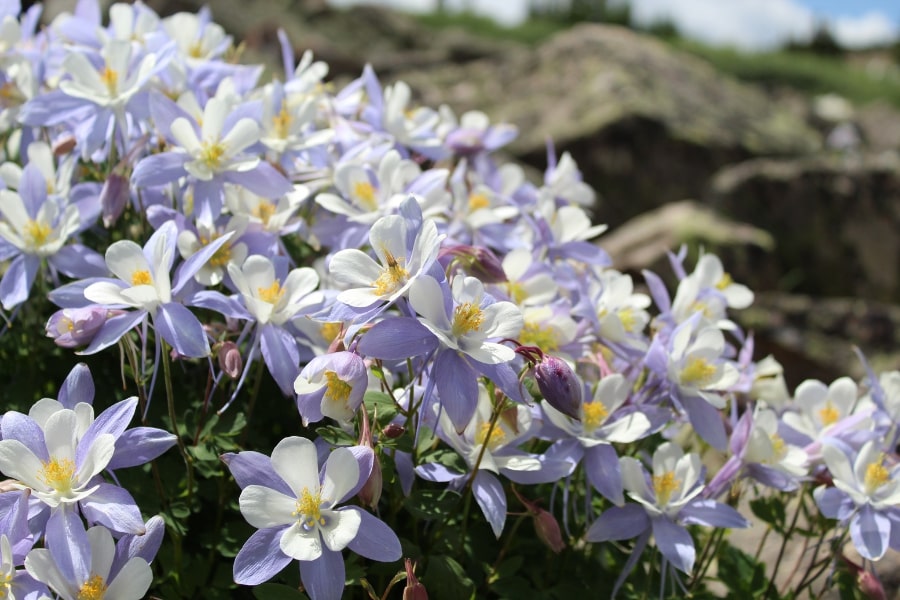Columbine (Aquilegia) is a genus of herbaceous perennials that belong to the Ranunculaceae family. The plant is known for its delicate, bell-shaped flowers that bloom in shades of blue, pink, purple, red, white, and yellow. These plants are available in many different cultivars, each with its unique features. They can grow from 6 inches to 3 feet tall, with a spread of up to 2 feet.

Our Selection of Columbine
At Martin Garden Center, we love Columbine. We start Columbine plants in the Fall to ensure that we have them in time to capture their amazing spring flowers. We currently grow varieties including the Early Bird Series, but we also have grown McKana Giants, Winky Series, and the Swan Series. These are also commonly grown by our vendors.
In the spring, we do our best to have 4″ varieties in all colors, 1-3 different hybrids per color, on our perennial tables. By May, these plants are usually sold out and will not appear again until the fall, when we bring them in again for overwintering. So shop smartly if you want Columbines for your gardens.
We are growing the following varieties in 2025:
Growing and Caring for Columbine
These plants thrive in well-drained soil with a slightly acidic to neutral pH. Proper soil drainage is crucial to prevent root rot, as Columbine dislikes soggy conditions. At Martin Garden Center, we grow our Columbines as full sun plants. However, we find that Columbines are less maintenance for our customers when planted in partial sun (meaning afternoon shade or less than 4 hours of afternoon sun).
Caring for Columbine includes consistent watering to maintain evenly moist soil. Applying a layer of mulch around the base of the plant can help retain soil moisture while also regulating temperature fluctuations. Fertilizing once a year, preferably in early spring, with a balanced, slow-release fertilizer can provide the necessary nutrients for healthy growth. Deadheading spent blooms will encourage prolonged blooming and prevent self-seeding (which can sometimes result in hybrid plants.) Additionally, pruning back the foliage after flowering can help promote fresh growth and prevent the plant from becoming leggy.
Columbine can sometimes face challenges such as aphids or powdery mildew. Regularly inspecting the plant’s leaves and stems can help you catch any issues early on. If aphids appear, insecticidal soap can help control their population. Preventing overcrowding and ensuring proper air circulation can reduce the risk of powdery mildew. Copper fungicide is also a potential organic solution to prevent powdery mildew.
Leaves and Flowers
The foliage of Columbine is fern-like with a delicate texture. The compound leaves, often bluish-green or gray-green in color, comprise numerous small leaflets that create an almost feathery effect. This foliage emerges in clusters, forming a mound that acts as a canvas for the plant’s enchanting blooms.
Columbine’s flowers resemble elegant bells or spurred tubes and come in a captivating range of colors. One of the most stunning features of the columbine flower is its unique spurs, which extend backward from the petals, evoking an almost whimsical appearance. These spurs are often contrasting in color, adding to the overall allure. Additionally, the intricate nectar guides within the flower, often in the form of delicate lines or dots, direct pollinators toward the source of nectar.

Uses in the Garden
With its intricate and graceful flowers, Columbine can draw the eye and serve as a captivating centerpiece in garden beds or borders. Its diverse color palette, ranging from soft pastels to vibrant hues, allows for creative combinations and harmonious contrasts with other plants, enhancing the overall aesthetic of the garden. However, Columbine also excels as a charming companion plant. Its delicate foliage and dainty flowers make it an excellent choice for planting alongside other perennials, shrubs, or grasses.
Columbine’s versatile nature allows it to thrive in various garden styles, from cottage gardens to woodland landscapes. Columbine can contribute to a woodland or shade garden, placed beneath taller trees or within dappled shade, creating a serene and magical atmosphere. Its ability to self-seed can lead to delightful surprises, as new columbine plants may emerge in unexpected corners of the garden, adding a sense of spontaneity and natural beauty.

Frequently Asked Questions
Is Columbine a Perennial?
Yes, Columbine is a perennial plant. These plants typically bloom in spring and early summer; some varieties may even rebloom later in the season. Columbines are relatively hardy and can persist for several years, adding beauty to garden beds, borders, and woodland settings.
When Should I Plant Columbine?
Columbine is generally best planted in the early spring or fall, depending on your climate and local growing conditions. In regions with cold winters, plant columbine in early spring when the ground is workable, and frost is no longer a concern. Fall planting is also suitable in mild climates where winters are not severe. Plant columbine in early fall, allowing the roots to establish before the colder temperatures.
Is Columbine Toxic to Cats and Dogs?
Columbine (Aquilegia) contains compounds that can be toxic to cats, dogs, and other animals if ingested. The plant contains alkaloids, including columbin and colchicine, which can cause poisoning symptoms when consumed. Symptoms of columbine poisoning in pets may include vomiting, diarrhea, lethargy, drooling, and, in severe cases, more serious complications. Contact your veterinarian immediately if you suspect your cat or dog has ingested Columbine.
